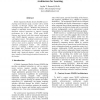Free Online Productivity Tools
i2Speak
i2Symbol
i2OCR
iTex2Img
iWeb2Print
iWeb2Shot
i2Type
iPdf2Split
iPdf2Merge
i2Bopomofo
i2Arabic
i2Style
i2Image
i2PDF
iLatex2Rtf
Sci2ools
ICALT
2006
IEEE
2006
IEEE
Augmented Learning: Context-Aware Mobile Augmented Reality Architecture for Learning
Mobile Augmented Reality System (MARS) based elearning environments equip a learner with a mobile wearable see-through display that interacts with training/learning software. MARS has the potential to adapmt to individual learner needs and dynamically distribute tailored instruction to improve learning performance for a life time. While using MARS, learners may interact with their natural environment while MARS digitally annotates real-world objects with digital content. This digital content may combine multi-modal animation, graphics, text, and video as well as voice used to augment instruction based on empirical pedagogical models. The challenge, however, is building a MARS software architecture that fulfills this potential and is also reusable, interoperable, and adaptive to individual Augmented Reality (AR) “heads-up displays” while, at the same time, capable of delivering personalized instruction to the learner.
Augmented Reality | ICALT 2006 | Learners | Machine Learning | MARS |
| Added | 11 Jun 2010 |
| Updated | 11 Jun 2010 |
| Type | Conference |
| Year | 2006 |
| Where | ICALT |
| Authors | Jayfus T. Doswell |
Comments (0)

